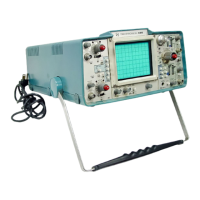Circuit Description—455/A2/B2
more negative charge. The more negative the voltage across
C548, the later Q552 turns on. See Figure 4-1 showing
voltage at C548. If the —2 kV starts to go less negative,
C548 is allowed to maintain a more-positive charge, thus
Q552 turns on sooner.
High-Voltage Circuitry
The secondary windings of the high-voltage transformer
provide crt heater current, voltage for the +95 volt supply,
and three 45 kHz sine-wave voltages (150 volt peak at
terminal 8, 2 kV peak at terminal 9, and 3.3 kV at terminal
10) to the encapsulated module, U550. Encapsulated
module U550 houses a high-voltage multiplier, a dc restorer
circuit and high-voltage rectifiers and filters for the crt
voltages; —2 kV (pin 9) and —2.1 kV (pin 4), adjustable
from —2050 volts to —2090 volts by R532.
The CRT Bias adjustment R532, connected to pin 2 of
U550, is adjusted to set the level at which the Z Axis Ampli
fier circuit extinguishes the crt display.
Crt Control Circuits
Crt-display focus is controlled by FOCUS control R564.
ASTIG adjustment R576, which is used in conjunction with
the FOCUS control to provide a well-defined display, varies
the positive level on the astigmatism grid. Geometry adjust
ment R572 varies the positive level on the horizontal deflec
tion plate shields to control the overall geometry of the
display.
Two adjustments control the trace alignment by varying the
magnetic field around the crt. Y Axis adjustment R573
controls the current through L573, which affects the crt
beam after vertical deflection, but before horizontal deflec
tion. Thus, it affects only the vertical (Y) components of
the display. TRACE ROTATION adjustment R571 controls
the current through L571 and affects both vertical and
horizontal components of the display.
Z Axis Amplifier
The Z Axis Amplifier circuit controls the crt intensity level
from several inputs. The effect of these input signals is
either to increase or decrease the trace intensity, or to com
pletely blank portions of the display. The input transistor
Q514 is a current-driven, low-input-impedance amplifier. It
provides termination for the input signals as well as isolation
between the input signals and the following stages. The
current signals from the various control sources are connect
ed to the emitter of Q514 and the algebraic sum of the
signals determines the collector conduction level.
Transistors Q518, Q526, and Q524 compose a feedback
amplifier stage, with R515 and R516 as the feedback elements.
Capacitors C515and C516 provide high-frequency compensa
tion. Q518 is an emitter follower providing drive to com
plementary amplifier Q526-Q524. Diodes CR525, CR518,
and CR524 provide protection in the event of high-voltage
arcing.
When the BEAM FINDER pushbutton is pressed, the output
of the Z Axis Amplifier moves to a fixed level so that the
crt is unblanked. Any incoming Z Axis signals are discon
nected from the amplifier by the reverse bias on CR514.
With the BEAM FINDER pushbutton pressed, +32 volts is
removed from R51 2 and +5 volts is applied to R504. This
reduces the current in Q514, which turns off CR514 and
disconnects the Z Axis input from Q518. Current through
Q526 decreases and its collector voltage goes up due to
feedback resistors R515 and R516. This action supplies
additional current to the base junction of Q518, thus re
placing current previously flowing through R503. The
increased voltage on the collector of Q526 unblanks the crt
which provides a visible display even though the crt might
otherwise be blanked or unintensified.
LOW-VOLTAGE POWER SUPPLY ^
Description
The low-voltage Power Supply circuit provides three of the
regulated low voltage sources (+5 volts, —5 volts, +32 volts)
used to operate the main, vertical, and horizontal modules.
A fourth low-voltage supply, +95 volts, is produced in the
CRT circuit.
The +32 volts is zener referenced and adjustable with the
+32 volt internal calibration adjustment (R736). All other
regulated supplies in the instrument, including the +95 volt
and crt high-voltage supplies, depend on the +32 volts for
their accuracy.
Setting the +32 volt supply accurately, with the +32 volt
adjustment (R736), sets all other regulated-supply voltages
within specifications, providing the supplies are functioning
correctly.
Power Input
Ac power is applied to the primary of T700 through line
fuse F700, POWER switch S700, and the line voltage selec
tor switch S701. The line voltage selector switch S701
connects the split primary windings of T700 in parallel for
116 volts ac operation and in series for 232 volts ac. When
REV. A, OCT 1975
4-5

